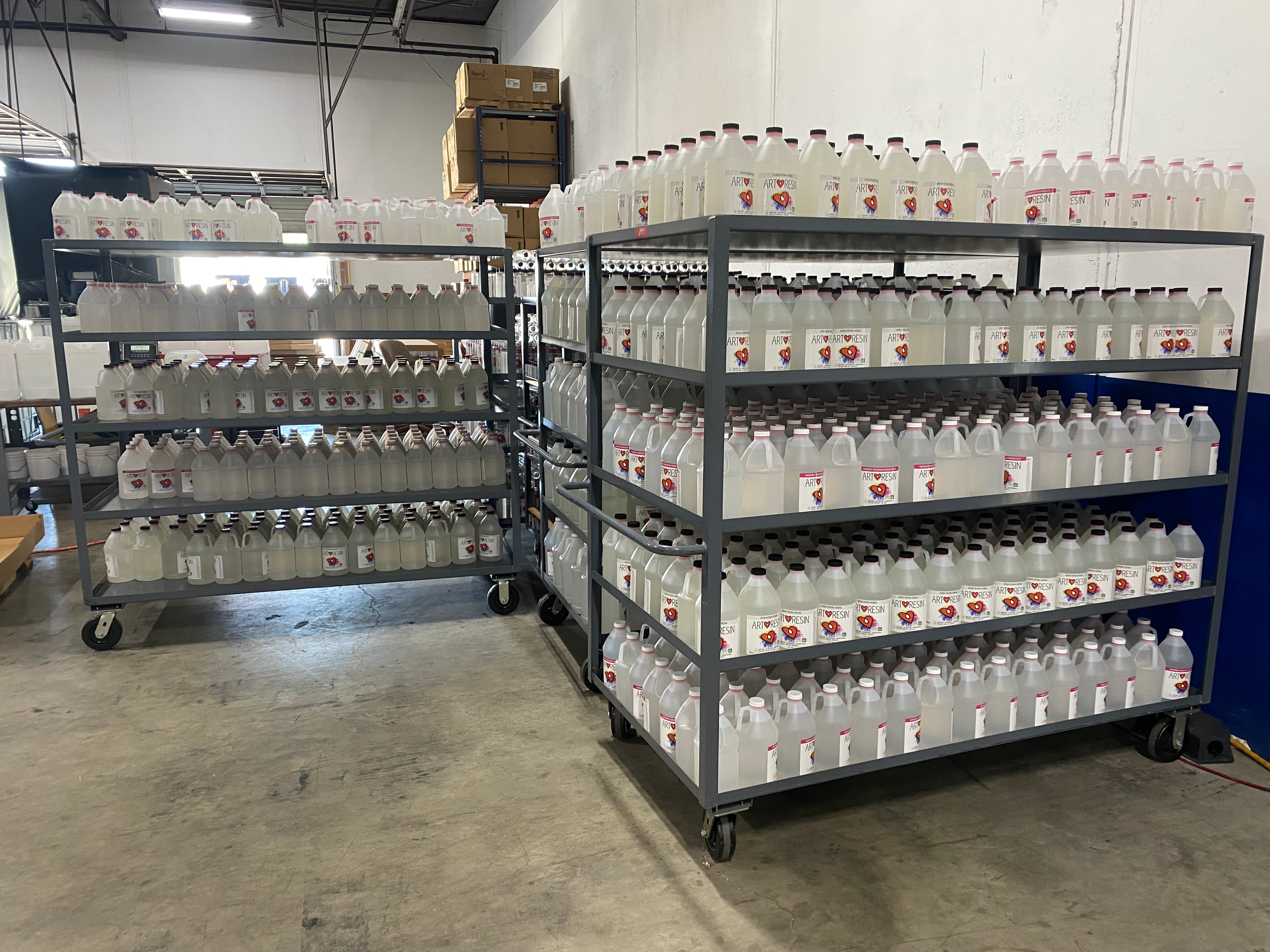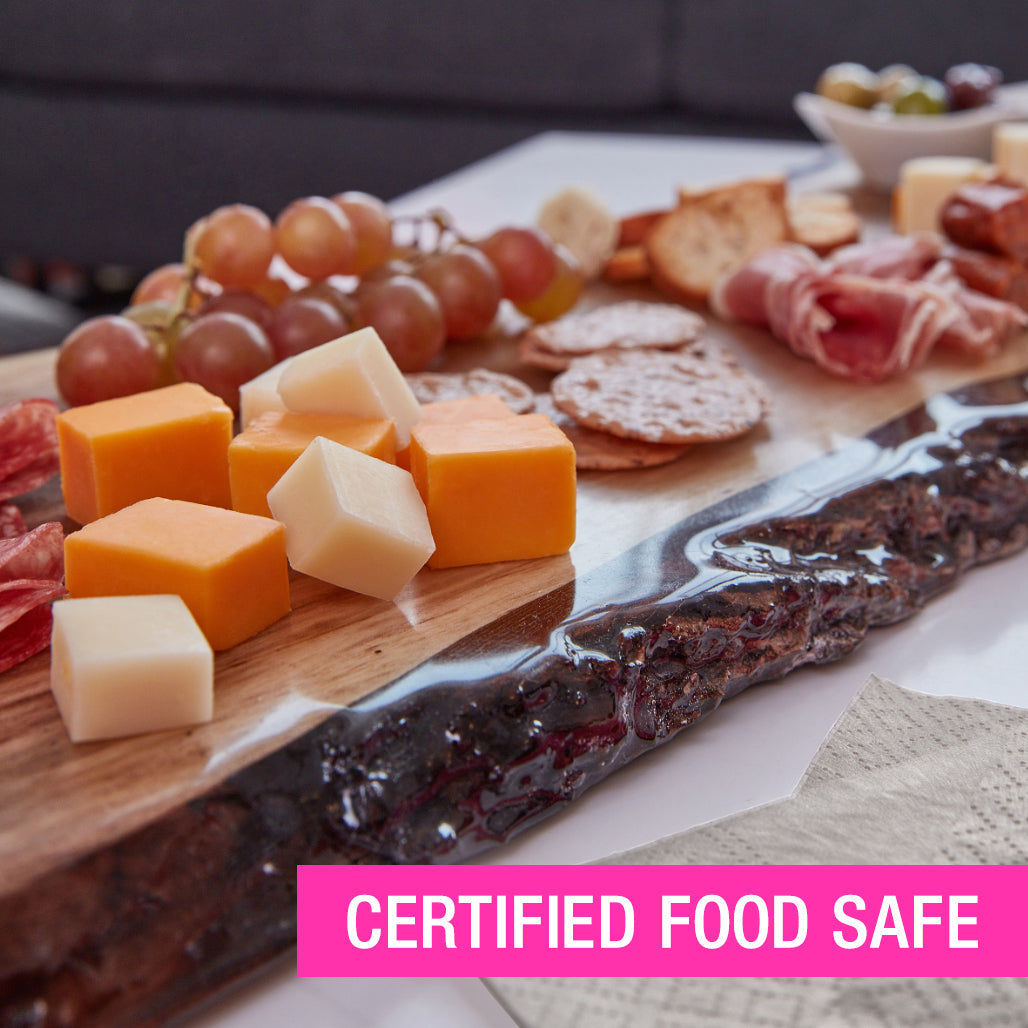Have you ever come across that glossy resin finish on paintings or crafts and wondered how to get that same gorgeous look on your own art?
Resin is a highly versatile material that has become popular among artists, crafters, woodworkers, and hobbyists. Resin offers endless creative possibilities and can be used to make artwork, DIY jewelry, trays, decorations, coasters, tables, and many other home decor items.

In this blog, we'll take a closer look at resin’s properties, the different types of resin available, and how you can use it to create your own beautiful projects. If you've ever been curious about resin—what it's made of, how it works, and what you can do with it—then you're in the right place.
Let's get started with the basics ...
What Is Resin?
Resin is a clear plastic-based material that comes as two separate liquid components known as the resin and the hardener. When mixed together, they chemically bond and solidify, typically within 24 to 72 hours. Once cured, resin is rock hard, glossy, durable, and resistant to chemicals and water.

Resin is highly versatile and there are many different types available, each tailored for specific applications. For example, resins such as ArtResin are specifically designed for creative projects in home or studio environments. ArtResin prioritizes clarity, quality, safety, and ease of use, making it ideal for creating clear, glossy finishes on paintings or photographs and for projects like home decor, jewellery and craft pieces.
💡 TIP: Learn how to use ArtResin on your artwork in our blog How To Use Epoxy Resin.

There are also resin formulas such as Industrial Clear, designed to be harder curing for river tables, countertops, and floors. Casting resin are yet another type of resin, designed for deep, bubble-free pours to encapsulate objects in a thick resin layer.

On the opposite end of the spectrum, some resins are designed for heavy duty, industrial purposes. These are typically less refined than resins designed for home use and pose significant health risks, requiring the use of protective equipment and significant safety precautions during use.
💡TIP: Learn more in our blog Types Of Resin And Their Uses.

What Is Resin Made Of?
Resin is made from a mixture of organic compounds, but the exact composition varies depending on the brand, formula, and intended use. For example, ArtResin's formula consists of a clear, epoxy-based polymer resin and a hardener that prioritizes clarity, safety, and ease of use. Mixing the two components creates a crystal-clear liquid ideal for pouring over artwork. Once cured, ArtResin gives your art pieces a transparent, glossy, mesmerizing, durable layer of protection that makes color pop!

What Are The Main Types Of Resin?
There are two main types of resin: natural and synthetic.
Natural resin is a sticky, organic substance produced by trees and plants to protect against insects, injuries, and diseases. Natural resin is commonly sourced from trees like spruce and pine, as well as certain flowering plants. After harvesting and processing, the resin is used to make adhesives and varnishes.
Synthetic resin, on the other hand, is a polymer manufactured through chemical reactions to replicate the properties of natural resin. Synthetic resin is commonly used in coatings, plastics, art pieces, adhesives, and composite materials.
Each type of resin has its own distinct properties and advantages that make it suitable for various applications. Below, you'll find a list of some of the most common natural and synthetic resins.
Natural Resins
Copal
Copal resin, derived from Central and South American tree species such as the slash pine, guaiacum officinale, and red gum, is commonly used in perfume and pharmaceuticals.
Pine Resin (Rosin)
Pine resin is a yellow resin derived from pine trees. Traditionally used by Native Americans to treat skin irritation, rheumatism, digestive issues, cough, and cold, it's now used in the production of varnishes, adhesives, and inks.
Dammar
Dammar resin comes from certain tropical trees, such as the Massoia tree. It’s often used in oil paints, varnishes, cosmetics, lacquers, waxes, candles, and traditional incense.
Frankincense
Frankincense, produced by the Boswellia tree, has been valued since ancient times for its medicinal and spiritual properties. Today, it's used in perfumes and skincare products.
Amber
Amber, a fossilized resin appreciated for its beauty and color since ancient times, is commonly used in jewelry and decorative objects.
Synthetic Resins
Epoxy Resin
Epoxy resin is the most widely known synthetic resin. It's used for a variety of applications such as coating, laminating, casting, molding, encapsulating, and adhesives. Epoxy resin is a thermosetting polymer that sets when exposed to heat or a catalyst. It's favored for art and craft projects, countertops, flooring, and adhesives.
Polyurethane
Known for its durability and flexibility, polyurethane is applied in liquid form to surfaces or molded in solid form. A highly durable and versatile synthetic resin, it's commonly used for flooring, coating wood projects, and creating medical prostheses due to its superior abrasion resistance.
Acrylic
A very common resin type due to its versatility and affordability, acrylic is clear, lightweight, and plastic-like. It's used to produce films, colored sheets, and fibers.
Polycarbonate
Strong and shatter-resistant, polycarbonate is ideal for eyewear frames, electronic devices, storm windows and shutters.
Polyester
A low-viscosity resin made from a chemical reaction of an alcohol and a diacid, polyester resins are used to produce storage tanks, pipes, waterproof linings, and equipment for marine and aerospace industries.
Vinyl Ester
A versatile polymer used in various applications including medical devices, electrical insulation, industrial tanks and pipes, and parts of marine and automotive vehicles.
💡TIP: Learn more about synthetic resins in our blog Types Of Resin And Their Uses.
What Are The Main Properties Of Epoxy Resin?
Versatility
Epoxy resin's versatility is unmatched. It can be poured in various thicknesses, tinted with pigments for a range of opaque or transparent colors, and finished with either a matte or glossy look. Resin adheres to most materials including fabric, wood, metal, concrete, glass, and more. It's perfect for crafting art, home decor, furniture, jewelry, and countless DIY projects. Some epoxy resins, such as ArtResin and Industrial Clear, are also food-safe once cured and can be used to create charcuterie boards, serving trays, dishes, bowls, and other items intended for serving food.
💡 TIP: Learn more about ArtResin's Food Safety in our blog ArtResin Passes Food Safety Tests.
Durability
Resin is known for its strength, durability, and resilience, making it suitable for crafting long-lasting projects. Once properly cured, resin is resistant to chemicals, water, and various weather conditions.
💡 TIP: Learn more in our blog Is Epoxy Resin Waterproof?
Weather Resistance
Resin compounds are capable of withstanding exposure to rain, snow, and other environmental elements. They can also endure significant temperature changes without losing their shape or strength. ArtResin also contains UV light stabilizers to help delay the damaging effects of the sun. Of course, it makes sense to avoid placing cured resin in direct sunlight to prevent premature yellowing.
💡 TIP: Learn more in our blog Can Resin Art Be Hung Outside?
Heat Resistance
Resins possess excellent heat resistance properties, although the exact degree depends on the resin type and its formula. For example, ArtResin, formulated for artwork coatings, can withstand temperatures up to approximately 50°C/120°F. On the other hand, Industrial Clear epoxy resin, intended for furniture, woodworking projects, and other industrial applications offers a higher heat resistance of up to 176°C/350°F.
Exposure to temperatures exceeding a resin's heat resistance may cause softening, but it will harden up again once cured, however there is a chance of warping while softened. Hence, it's important to select a resin suitable for the desired application and adhere to the manufacturer's guidelines for temperature resistance.
Ease of Use
Resin is quite an easy material to work with, especially when compared to wood or metal. It easily takes many different forms and can be used to produce a wide variety of objects. It allows for techniques such as pouring, casting, and brushing-on, that can simplify the application process. However, always follow manufacturer guidelines and safety precautions when working with resin.
Relatively Low Cost
In many cases, resin is more cost-effective than alternative materials. Of course, you get what you pay for, so the costs depend on factors such as quality, resin type, the intended use, and safety aspects.
Safety
It's important to prioritize safety when working with resin, as not all resins are created equally. For projects in home or studio settings, such as resin art or DIY crafts, choose a high quality resin deemed safe for these environments. Consult the Safety Data Sheet (SDS) for required personal protective equipment and the Technical Data Sheet for details on clarity, viscosity, cure time, UV resistance, and odor.
💡 TIP: ArtResin provides its SDS and Technical Data Sheets on the website for reference.
What Are The Uses Of Resin?
Resin can be used in a wide range of practical and decorative applications. It can be used to coat paintings and photographs, to mold resin jewelry, coasters, and other home decor items, and to craft woodworking projects such as charcuterie boards or serving trays. It can also be used to create river tables, bar tops, countertops, and table tops, and can even be used as a protective coating against weather damage, for boat repair, and to prevent metal corrosion.
💡 TIP: Learn more about the Types of Resin And Their Uses.

What Is The Manufacturing Process Of ArtResin?
ArtResin is manufactured to the highest quality and safety standards to protect both the product and our employees. Unlike many other resin brands, ArtResin is manufactured in our own production facility in Dallas, Texas.
Our approach to safety and quality starts with the raw materials. ArtResin is a pure formula made from the highest quality ingredients with no solvents or cheap diluents to stretch the materials. As a result, ArtResin is a complete formula, meaning that all the ingredients in the resin and the hardener react with each other, leaving nothing behind that can become airborne and breathed in.
Our facility is also certified to be environmentally safe. We have a containment system in place for our raw materials and, since our manufacturing process does not require water, so there is no risk of these raw materials entering the water system.


Once ArtResin has been manufactured, bottled, and labelled, the final step is shipping. After ensuring the individual bottles have been quality checked by our our production team, they are packaged up and transported directly to you, the customer, or to our retail partners.
ArtResin is prepared in small batches to ensure that you receive the freshest product possible!
Pros & Cons Of Resin
The pros and cons of resin depend on the intended use. On the plus side, resin is durable, long-lasting, weatherproof, and relatively inexpensive compared to other materials like wood. It is, in fact, one of the most versatile materials on the market. You can use clear resin as a coating for artwork or pour it into molds to create custom shapes from scratch which will last for years. ArtResin is also food safe once cured.
The cons of resin vary from type to type. For example, some resins on the market contain solvent ingredients that can create serious health issues if ingested or inhaled. Luckily, there are also high-quality epoxy resins like ArtResin available, that come with several safety certifications. Lastly, since resin can take several hours to cure, it requires some planning.
💡 TIP: Are you brand new to resin art? Learn how to get started in our blog How Do Beginners Use Resin?

Resin Safety Considerations
ArtResin is a high-quality, non-toxic resin designed specifically for home artists and crafters. It conforms to ASTM D4236 (Safe for Home Use) when used according to the label directions. It contains no volatile organic compounds (VOCs), no fumes, no solvents, and is non-flammable and non-hazardous. It has been extensively tested and meets requirements for FDA 21 CFR 175.300, meaning it's safe to use as a food contact surface once cured.

Resin & Environmental Impact
Is resin considered harmful to the environment?
In general, natural resins are neither toxic nor harmful to the planet. However, many types of synthetic resins are made with highly toxic ingredients that can pose a health risk to the user, including skin corrosion and lung damage. These toxic ingredients also have catastrophic effects on waterways, marine life, and the environment. Some of these ingredients, such as benzyl alcohol, can leach out of certain resins, even after curing.
ArtResin is one of the safest epoxy resin options on the market. ArtResin contains no fillers and no solvents that can cause unwanted toxic health effects to the user. Everything in the ArtResin formula bonds together chemically, and that means no VOCs or fumes that can cause respiratory distress. Although ArtResin does not contain dangerous solvent ingredients, the amines in the liquid hardener may be harmful to aquatic organisms. We always recommend disposing of ArtResin after curing, at which point the product is entirely inert (meaning nothing will leach out) and cannot contaminate the environment.
💡 TIP: How do you know if a resin is safe or not? The answer can be found in the Safety Data Sheet. Learn how to read and understand a Safety Data Sheet in our blog How Dangerous Is Your Epoxy Resin?

ArtResin Epoxy Resin
Want to make your art pop? ArtResin's high-gloss epoxy resin can be used to coat paintings and photos or to craft stunning DIY pieces made to impress!
Here are our Top 10 Easy Resin Projects to get started with!
Check out these blogs for more information, project ideas, and tips on the colorful world of epoxy resin:
- Learn how to make Resin Art For Beginners.
- See our list of the Top Resin Art Tools.
- Make the Top 20 Resin Crafts Using Epoxy Resin.
- See the Top 10 Resin Mistakes Made By Beginners.
- Curious about What Resin Art Sells Best and Where To Sell Your Resin Art?
ArtResin: The Original Epoxy For Resin Art.

